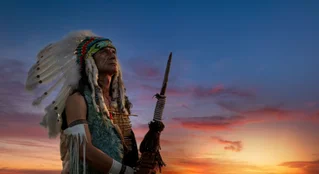
The Association on American Indian Affairs
Creating a world where diverse Native American cultures and values are lived, protected and respected.
The first thoughts in most peoples’ minds when thinking about Native Americans may involve a tall, angular, scantily clad brown man with long braids wearing a headdress, or a “Cherokee princess,” or perhaps an exhibit of pottery, arrows and shields behind glass with a diorama set in the beautiful past within the confines of a museum. We are portrayed as mystical, stoic and primitive on a can of baking powder; our Native names, often meaning “the People,” used to label helicopters and cars. These images perpetuate stereotypes of Native peoples, keeping us in the past and invisible – though we exist all around as you stand upon our homelands we continue to pray for. Many people believe that Native Americans did not survive the European invasion – or at least, we somehow do not exist as contemporary people that you pass by in the supermarket or on your way to work.
But we are still here. There are 574 federally recognized Native Nations and more than 300 other state recognized and other Tribal bands and groups that have survived 500 years of European and western colonization and government policies of assimilation and genocide. We are 9.7 million people in the United States – that is about 2.9% of the U.S. population (and these numbers are likely undercounted by the census). We come from diverse peoples that have homelands on every inch of Turtle Island you call the United States. Each of our Nations have unique languages, cultural and religious practices, governance systems, courts, schools, and government-to-government relationships with federal, state and local governments.
The Association on American Indian Affairs' Rich History
The Association on American Indian Affairs is the oldest nonprofit serving Indian Country protecting sovereignty, preserving culture, educating youth and building capacity. The Association was formed in 1922 to change the destructive path of federal policy from assimilation, termination and allotment, to sovereignty, self-determination and self-sufficiency. Throughout its 99-year history, the Association has provided national advocacy on watershed issues that support sovereignty and culture, while working at a grassroots level with Tribes to support the implementation of programs that affect real lives on the ground. The Association is a 501(c)(3) non-profit with an all-Native Board of Directors, CEO and staff. Anyone can be a member of the Association who supports our vision with a $35 annual membership fee.
What We Do; How We Serve
The Association has put a lot of effort into strengthening our Cultural Sovereignty – the values and lifeways that maintain our connection to all living things. We protect Sacred Places, repatriate our Ancestors bodies and their burial belongings, and sacred and cultural patrimony that has been stolen, hidden away in boxes and put up for sale. We also work to protect and strengthen Native American children and families, and the transmission of our languages and cultural values. We are the oldest Native American scholarship program and Native Youth Summer Camp grant program. And, just as important, we spend a lot of our time making sure the public knows about the vision and values we share to make our collective-shared world a better place.
One way we educate the public is through our video podcast called Red Hoop Talk. RHT highlights Native Americans from all over Indian Country and how they work for their people and stay #closetoculture. We discuss various issues in Indian Country - from the missing and murdered Indigenous Peoples epidemic, to economic development, humor, food sovereignty in informal conversations. We strive to tell our stories in a way that showcases who we are and makes our concerns and views of the world accessible and personal to everyone. Our most current show went live on November 19 and is available (along with 69 other episodes) for viewing on our website and YouTube.
We are guided in all of our programs and initiatives by the concept of #EverythingBack. It is an intentional movement towards reconciliation, reparation, return – healing and making whole – of everything that was stolen, taken, and looted without free, prior, and informed consent. #EverythingBack is about shared values for the environment, diversity, family and community. #EverythingBack is a call to action to Indian Country, our allies, and supporters to stand united and demand that the very things that make us who we are as human beings and autonomous sovereign Nations, are returned. This movement is for the healing of Native Nations and their citizens, as well as a healing for all of us as we take accountability in our roles to take care of the Earth, and one another.
How Can You Support The Association on American Indian Affairs
If you share our values, you can help support our work into our next 100 years of service. Donate to support the Association’s ongoing work to protect Cultural Sovereignty. Help us advocate and educate about how the principle of #EverythingBack can guide us to a better shared future for all.
Written by Shannon O'Loughlin, a citizen of the Choctaw Nation of Oklahoma, and Chief Executive and Attorney for the Association on American Indian Affairs. Connect with her on LinkedIn, and learn more about the organization at: www.indian-affairs.org


